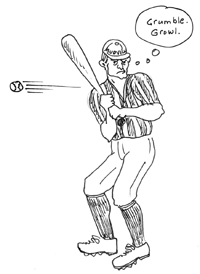STRANGE BUT TRUE- Strike three! Homers take more brain than muscle

DRAWING BY DEBORAH DERR McCLINTOCK
Q. In the classic 1888 poem "Casey at the Bat," he clenches his teeth in hate as he violently pounds his bat upon the plate, then takes his final swing. Unfortunately, there was no joy in Mudville that day as mighty Casey struck out. Does modern neuroscience offer any clues about what went wrong? –J. Jane
A. Modern biomechanists know that to hurl a fastball, the pitcher must muster 3-4 horsepower, using 24-32 pounds of muscle mostly in his back and thighs, says John Milton (not that John Milton) in Your Brain on Cubs. Because this necessitates a careful kinetic sequence, the windup is loaded with clues for the batter, whose "mirror neurons" can help signal the type of pitch that's coming. "This may help explain the fact that a great pitcher, Babe Ruth, was also one of the greatest home run hitters of all time," Milton says poetically.
To counter the batter "reading the windup," the pitcher uses deception and distraction, sometimes throwing pitches with unpredictable trajectories like the knuckleball. "The neural programs inside the hitter's brain will work best if he attends only to the most relevant information."
So why did Casey strike out? From a brain perspective, says Milton, he ignored the first two pitches (no contribution to anticipatory skill), he was angry (irrelevant information), and he played to the crowd (distraction of attention). "The take-home message from Casey's fate is that hitting requires not just muscle strength but also a focused, fine-tuned brain."
Q. Why is the U.S. Federal Aviation Administration (FAA) hurling thawed dead birds at 200 mph into a machine that shreds the carcasses into thousands of tiny pieces? –A. Hitchcock
A. Ubiquitous high-flying flocks of birds collide with commercial aircraft, causing an estimated $1 billion damage worldwide every year, says Clara Moskowitz in Discover magazine. So the FAA simulates inflight collisions to monitor potential damage to aircraft engines: In one "bird strike" test, technicians at General Electric's facility in Peebles, Ohio, suspend an engine from a giant stand, then start its turbines spinning full force before loading four thawed goose carcasses into a 50-foot-long steel tube and firing them at 200 mph into the engine blades.
Passing the test with flying colors was a GEnx jet engine intended for the 787 Dreamline, to be delivered to Japan. So far, real bird carcasses have been used, but synthetics are now being developed–less messy and easier to standardize.
Taking a different approach, the U.S. Air Force's Bird Aircraft Strike Hazard prevention program is culling data to map bird routes to help planes avoid sharing airspace with large flocks.
Q. It's often said that gentlemen prefer blondes, and in many Western cultures surveys confirm this. But does this make men happier? What might an economist argue? –J. Frost
A. Think in terms of marketplace value, says Robert Frank in The Economic Naturalist: In Search of Explanations for Everyday Enigmas. According to "assortative mating," 10's tend to marry 10's, 9's tend to marry 9's, and so on. For example, a 9-point man might hope to marry a 10-point woman, but she would have better options, so he can more realistically expect to marry a 9-point woman.
For people of either sex, a wide variety of mixes of personal characteristics could produce an overall index value of 9. So if being blonde contributes positively to a woman's attractiveness index, then a 9-point blonde will tend to have less favorable values than a 9-point brunette for all other characteristics that enter the mix.
"On the average, a 9-point blonde will be less healthy, less intelligent, less kind, and less pretty on dimensions other than hair color," Frank says. "So if a gentleman could choose to prefer brunettes, he might have good reasons for doing so."
Oh, well, who ever said economists always know best.
Q. Classic numbers noodler directs you to write down any multi-digit number without repeat digits, e.g., 8491 but not 8498, then rearrange the digits anywhichway (e.g., 1498), then subtract the smaller number from the larger (8491 - 1498 = 6993). Now add up the digits in your answer (6 + 9 + 9 + 3 = 27). If this yields a multi-digit number, tally the digits again (2 + 7 = 9). What number did you end up with? See the trick here? –R. Descartes
A. Whatever your original number, your answer will always be 9, once you arrive at a single digit, says California State Polytechnic University mathematician Laurie Riggs. "Amazing!"
Q. Don't laugh. It was hard work developing the flush toilet. For instance, careful thought had to go into what test materials to use in simulated flushings, for certainly the real stuff was inadvisable. What did the developer use? –M. Clean
A. As recounted in the book Flushed with Pride: The Story of Thomas Crapper, one of his early "super-flushes" successfully cleared away 10 apples averaging 1 3/4 inch in diameter, 3 air vessels, a pan coated with plumber's "Smudge" and four pieces of paper adhering to the soiled surface.
Send Strange questions to brothers Bill and Rich at [email protected]
#